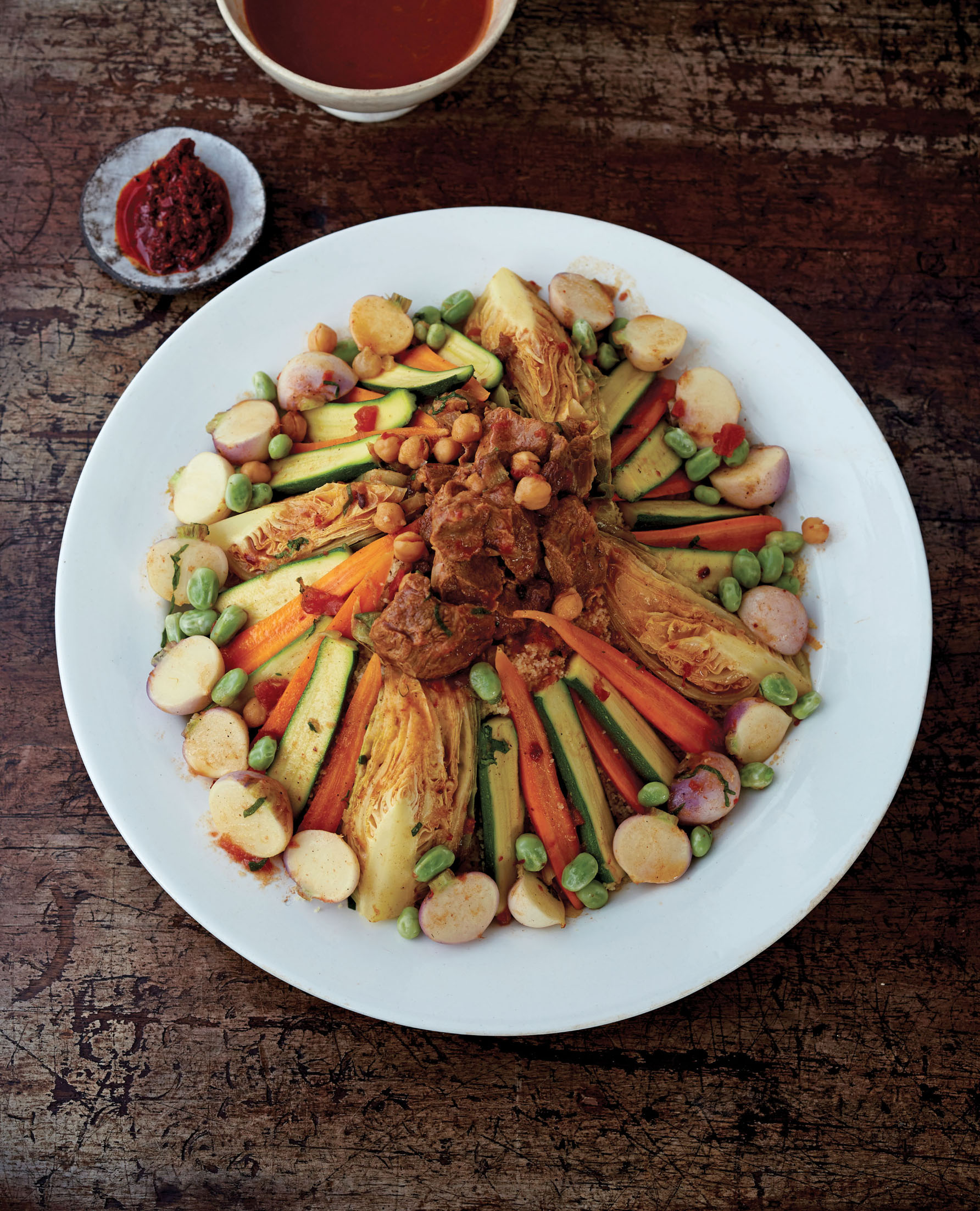Couscous with Seven Vegetables
KSEKSÛ BIDAWI
MOROCCO

Friday is couscous day all over Morocco, and this couscous with seven vegetables is what families will gather around every Friday at lunchtime. The classic vegetables are carrots, zucchini, cabbage, pumpkin, turnips, fava beans, and tomatoes to enrich the cooking broth, but you can use eggplant if you want or potatoes or sweet potatoes or whatever is in season or takes your fancy. I often use baby vegetables for a prettier presentation, but normal-size vegetables are what everyone uses in Morocco. The presentation may be less dainty, but if they are cut well and not overcooked, they will look just as attractive.
SERVES 6
FOR THE COUSCOUS
2½ cups (500 g) fine or medium couscous (not instant)
Sea salt
1 tablespoon extra-virgin olive oil
2 tablespoons (30 g) unsalted butter, melted
FOR THE MEAT AND BROTH
½ cup (100 g) dried chickpeas, soaked overnight in plenty of water with ¼ teaspoon baking soda
1 pound 2 ounces (500 g) boneless lamb, neck fillets or meat from the shanks
Good pinch of saffron threads
2 medium onions (10½ ounces/300 g total), quartered
One 14-ounce (400 g) can chopped tomatoes
1 teaspoon finely ground black pepper
Sea salt
3 tablespoons extra-virgin olive oil
4 tablespoons (60 g) unsalted butter
TO FINISH
1 small conehead (pointed) cabbage, damaged outer leaves discarded, quartered
5 ounces (150 g) baby carrots
5 ounces (150 g) baby zucchini
5 ounces (150 g) baby turnips
5 ounces (150 g) frozen, unpeeled fava beans
A few sprigs flat-leaf parsley, most of the bottom stems discarded, finely chopped
A few sprigs cilantro, most of the bottom stems discarded, finely chopped
⅓ cup (50 g) golden raisins
¼ teaspoon red pepper flakes, or to taste
Harissa, for serving
1. To start the couscous: Put the couscous in a large shallow bowl. Measure ⅔ cup (160 ml) water into a small measuring cup and add 1 teaspoon salt. Stir until the salt is diluted, then with your hand, sprinkle the water onto the couscous, little by little, raking it with your fingers to allow it to absorb the water evenly. When you have used up all the water, add the olive oil and mix well, rubbing any lumps with your hands to break them up. Put the couscous in the top half of a couscoussière. (If you don’t have one, line with cheesecloth a metal colander that will fit over the pot you will use to cook the meat and broth. The pot should be deep enough that the colander doesn’t touch the broth underneath.)
2. To start the meat and broth: Drain and rinse the chickpeas and put them in the bottom half of the couscoussière (or a large pot). Add the meat, saffron, onion, tomatoes, and 6 cups (1.5 liters) water. Add the pepper and salt to taste and bring to a boil. Cook for 45 minutes, or until both the meat and chickpeas are just tender. Add the olive oil and 4 tablespoons (60 g) butter.
3. Continue cooking the couscous: Place the top part of the couscoussière (or colander) with the couscous in it on top of the broth. Cover and let steam for 15 minutes. Remove the top part of the couscoussière (or colander) and cover the pot. Let the meat and chickpeas continue to cook. Tip the steamed couscous into the shallow bowl and sprinkle with another ⅔ cup (160 ml) water, this time using a wooden spoon to stir the couscous as you sprinkle (unless your hands can stand the heat, which Moroccan cooks seem to be able to!). Once all the water is incorporated and there are no lumps, add the 2 tablespoons (30 g) melted butter. Mix well. Cover the bowl and let sit to allow the couscous to fluff up, while you finish the meal.
4. Add the cabbage to the bottom half of the couscoussière (or the pot) and cook for 15 minutes. Add the carrots, zucchini, turnips, fava beans, herbs, raisins, and pepper flakes to the broth. Return the couscous to the top half of the couscoussière (or the colander), place over the broth, and let steam uncovered for 15 minutes, or until the meat and vegetables are tender.
5. To serve, pile the steamed couscous in the shape of a pyramid in a large shallow serving bowl. Flatten the top and arrange the meat on top and the vegetables around the sides. Pour the broth into a sauceboat and serve hot, with harissa on the side for those who like their couscous spicy.